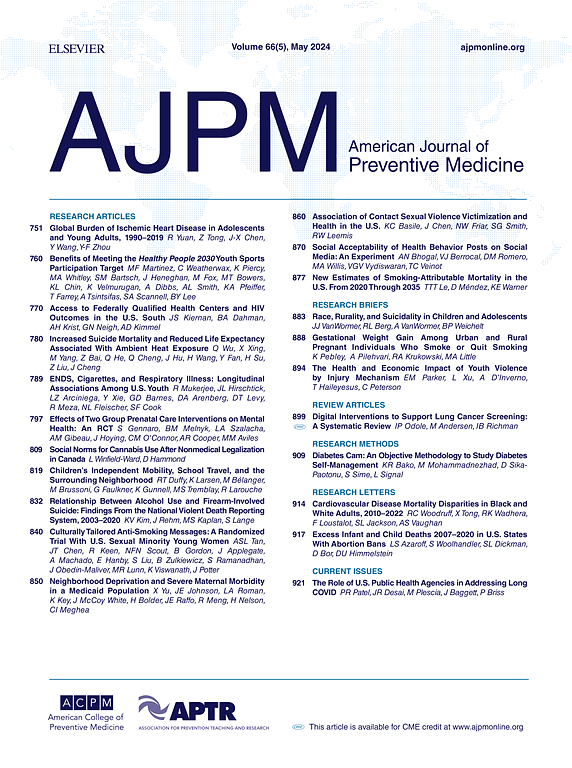社会经济地位低下或有严重心理困扰的人群吸烟与心血管疾病风险的差异:模拟分析。
IF 4.3
2区 医学
Q1 MEDICINE, GENERAL & INTERNAL
引用次数: 0
摘要
导言:在美国,社会经济地位低或有严重心理困扰(SPD)的人群吸烟率较高,这可能会增加这些边缘化亚人群患心血管疾病(CVD)的风险。我们估算了吸烟差异是如何导致心血管疾病差异的:使用烟草和尼古丁结果与政策模拟模型(一个经过验证的烟草使用和临床结果微观模拟模型),我们利用 2004-2019 年全国健康访谈调查的数据,首先比较了 40 岁人群 20 年累计心血管疾病发病率(按性别、吸烟状况和边缘化亚人群成员划分)。其次,我们模拟了具有代表性的年龄、性别和吸烟状况分布的边缘化亚人群,以估计现状和反事实情景下的 20 年累积心血管疾病发病率。在反事实情景下,低社会经济地位亚人群和SPD亚人群的吸烟率和趋势分别与高社会经济地位亚人群和非SPD亚人群的吸烟率和趋势一致:模型预测的吸烟对 20 年累积心血管疾病发病率的影响远远大于低社会经济地位或 SPD 的影响;例如,在 40 岁男性中,目前吸烟的低社会经济地位人群累积心血管疾病发病率为 28.3%,从不吸烟的低社会经济地位人群累积心血管疾病发病率为 13.0%,目前吸烟的高社会经济地位人群累积心血管疾病发病率为 26.2%。在第二项分析中,在维持现状的情况下,模型预测的 20 年累积心血管疾病发病率在低社会经济地位人群中为 19.3%,在高社会经济地位人群中为 22.1%;在反事实情况下,低社会经济地位人群的发病率为 18.1%,高社会经济地位人群的发病率为 19.6%:结论:以缩小吸烟差距为重点的干预措施可大幅降低边缘化亚人群的心血管疾病发病率。本文章由计算机程序翻译,如有差异,请以英文原文为准。
Disparities in Tobacco Smoking and Risk of Cardiovascular Disease in People With Low Socioeconomic Status or Serious Psychological Distress: A Simulation Analysis
Introduction
High tobacco smoking prevalence in people with low SES or serious psychological distress in the U.S. may increase cardiovascular disease risk among these marginalized subpopulations. The authors estimate how smoking disparities contribute to cardiovascular disease disparities.
Methods
Using the Simulation of Tobacco and Nicotine Outcomes and Policy model, a validated microsimulation model of tobacco use and clinical outcomes, the authors used 2004–2019 data from the National Health Interview Survey to first compare 20-year cumulative cardiovascular disease incidence for people aged 40 years by sex, smoking status, and marginalized subpopulation membership. Second, the authors simulated the marginalized subpopulations with representative age, sex, and smoking status distributions to estimate 20-year cumulative cardiovascular disease incidence under status quo and counterfactual scenarios. In the counterfactual scenario, smoking prevalence and trends in the low SES and serious psychological distress subpopulations match those in the higher SES and non-SPD subpopulations, respectively.
Results
The model-projected impact of smoking on 20-year cumulative cardiovascular disease incidence is considerably larger than the impact of low SES or serious psychological distress; for example, among males aged 40 years, cumulative cardiovascular disease incidence is 28.3% for low SES people who currently smoke, 13.0% for low SES people who never smoke, and 26.2% for higher SES people who currently smoke. In the second analysis, in the status quo scenario, model-projected 20-year cumulative cardiovascular disease incidence is 19.3% for low SES and 22.1% for serious psychological distress; in the counterfactual scenario, it is 18.1% for low SES and 19.6% for serious psychological distress.
Conclusions
Interventions focused on reducing smoking disparities could substantially reduce cardiovascular disease in marginalized subpopulations.
求助全文
通过发布文献求助,成功后即可免费获取论文全文。
去求助
来源期刊

American Journal of Preventive Medicine
医学-公共卫生、环境卫生与职业卫生
CiteScore
8.60
自引率
1.80%
发文量
395
审稿时长
32 days
期刊介绍:
The American Journal of Preventive Medicine is the official journal of the American College of Preventive Medicine and the Association for Prevention Teaching and Research. It publishes articles in the areas of prevention research, teaching, practice and policy. Original research is published on interventions aimed at the prevention of chronic and acute disease and the promotion of individual and community health.
Of particular emphasis are papers that address the primary and secondary prevention of important clinical, behavioral and public health issues such as injury and violence, infectious disease, women''s health, smoking, sedentary behaviors and physical activity, nutrition, diabetes, obesity, and substance use disorders. Papers also address educational initiatives aimed at improving the ability of health professionals to provide effective clinical prevention and public health services. Papers on health services research pertinent to prevention and public health are also published. The journal also publishes official policy statements from the two co-sponsoring organizations, review articles, media reviews, and editorials. Finally, the journal periodically publishes supplements and special theme issues devoted to areas of current interest to the prevention community.
 求助内容:
求助内容: 应助结果提醒方式:
应助结果提醒方式:


